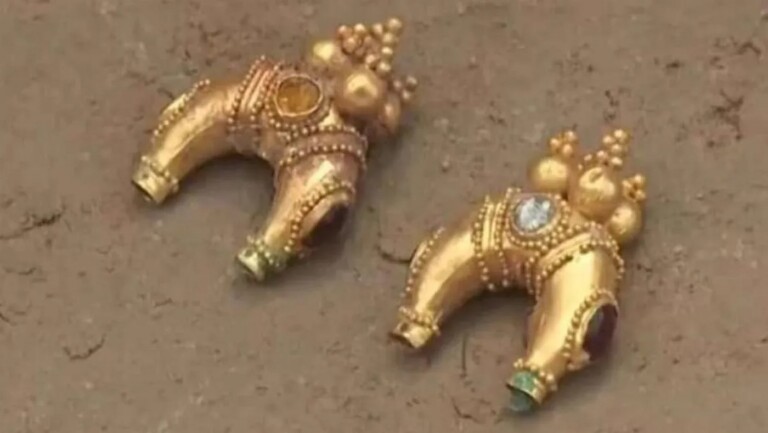Ty náušnice jsou brutálně krásný 👍🙂
2,000-year-old mounds with gold jewels on the Silk Road
Categories: Nálezy nejenom s detektorem na blízkém východě
Archaeologists in Kazakhstan's Turkistan have discovered burial mounds with rich equipment. Among the artefacts were gold jewellery, weapons and arrowheads or everyday objects. All from the period of the virtually unknown Kangju state between the 5th century BC and the 4th century AD.
A team made up of local archaeologists and representatives of Ozbekali Zhanibekov University has newly explored three mounds. Unfortunately, two had been completely looted in the past, while the third mound contained intact artefacts including a Roman fibula, a coravarious sizes, a ceramic jug, shoes, a belt buckle and an arrow used for hunting birds. There were also two gold crescent-shaped earrings decorated with precious stones and a luxury imported bronze mirror.
The earrings are made of "polychromatic" gold alloy, inlaid with turquoise amethyst and pink-red rubies. The crescent shapes are complemented by grape-shaped decorative elements at the ends, which have been deliberately designed to reflect light as much as possible. Polychromatic gold was often used in historical jewellery and works of art for its considerable visual appeal and symbolism, with the combination of colours often reflecting social status or cultural significance.
The bronze mirror, according to the technology and design used, in the shape of a circle with an octagonal arch at the back and a hole in the middle, dates from China during the Han dynasty between 206 BC and 220 AD. Such objects were highly prized and popular throughout Eurasia - similar mirrors have been found in Afghanistan or the southern Urals. The mirror in the grave goods suggests that its owner was a rich and influential person.
The finds demonstrate the highly developed craftsmanship and advanced trade links of the region. Kangju was situated along the ancient Silk Road in Central Asia; it was thus an ideal intermediary for trade between East and West. For nearly a thousand years, the kingdom maintained balanced trade relations with the first "golden" Han dynasty in the east or the Roman Empire in the west. It also traded with the Kushan Empire to the south.
The inhabitants of Kangju were of Indo-European origin, spoke a predominantly East Iranian language, and led a semi-nomadic, commercial, and not infrequently warlike way of life. Genetic research has revealed that there were people of various nomadic groups, such as the Sarmatians, Xiongnu and Saki, who were probably of Scythian origin.
Artefacts from the unclaimed mound will now be displayed at the National Museum in Astana. They provide valuable insights into the history and cultural relations of ancient civilizations, revealing further information about the people and kingdom of Kangju.
Roman Nemec
Sources: livescience.com, phys.org, goodnewsnetwork.org, archaeologymag.com
 Gold earrings with precious stones and beadwork
Gold earrings with precious stones and beadwork
 detail of gold earrings
detail of gold earrings
 bronze mirror belonged to a high-ranking person
bronze mirror belonged to a high-ranking person
 tomb with equipment
tomb with equipment
The article is included in categories:







